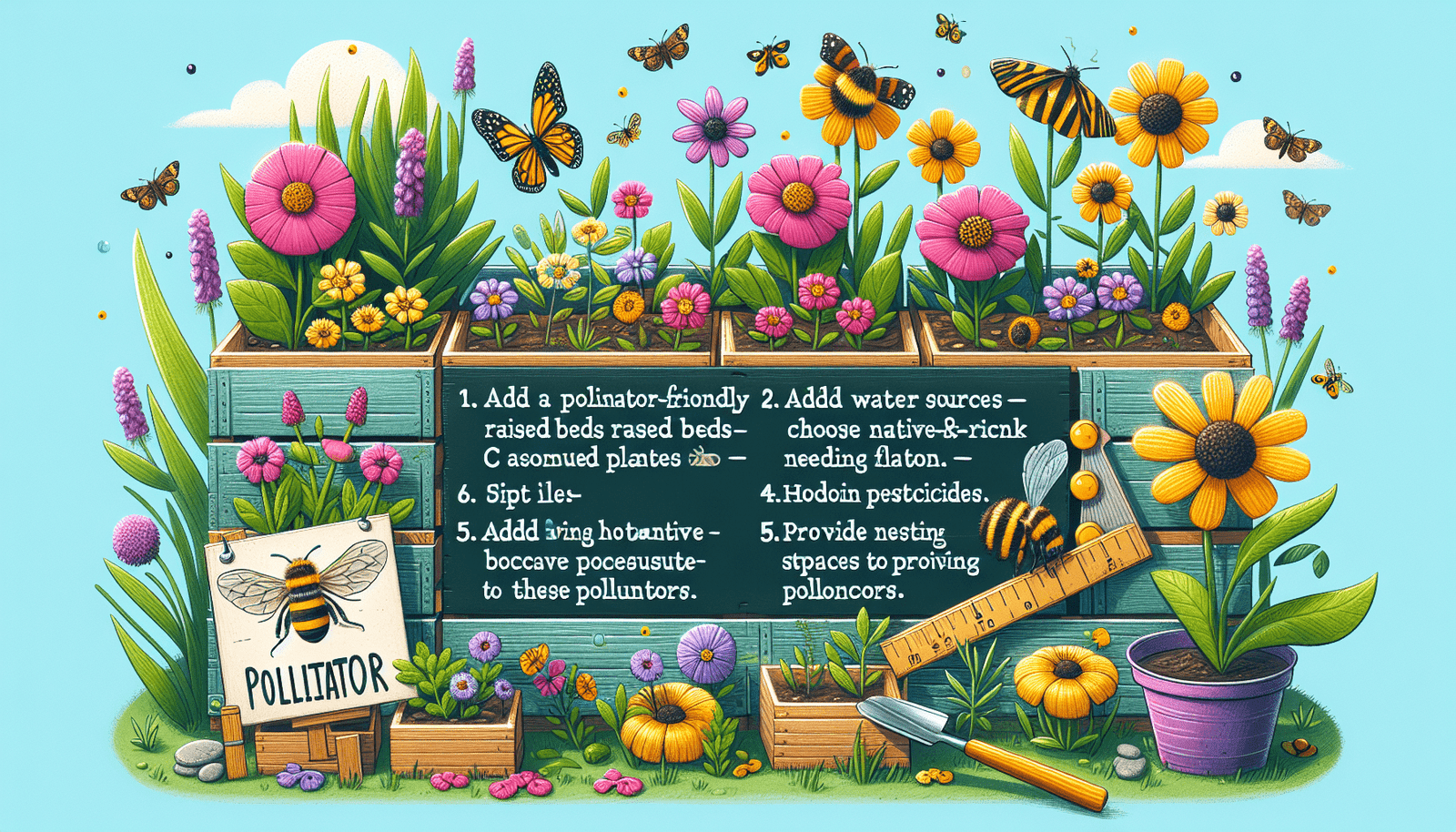Are you looking to enhance your garden while also supporting the local pollinators? Look no further than creating pollinator-friendly raised beds. By incorporating certain elements and practices into your raised bed design, you can attract and help sustain a wide variety of pollinators, such as bees and butterflies. Not only will this add a burst of color and life to your garden, but it will also contribute to the important role these pollinators play in maintaining healthy ecosystems. So, grab your gardening tools and let’s explore how to create a haven for these helpful creatures in your own backyard.
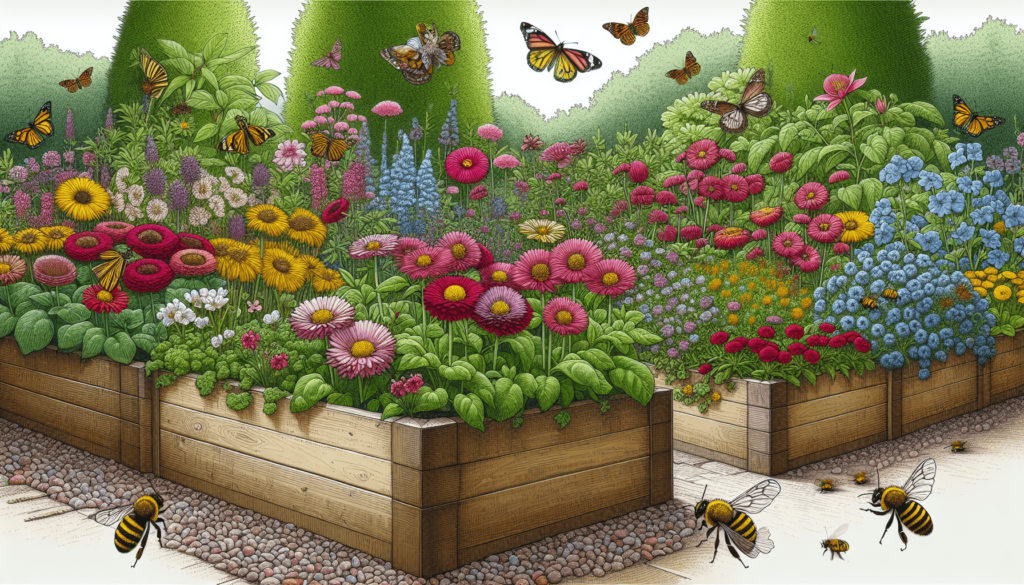
Choosing the Right Location for the Raised Beds
Considering sunlight exposure
When choosing a location for your raised beds, it’s important to consider the amount of sunlight the area receives. Most flowering plants require at least 6-8 hours of direct sunlight per day to thrive and attract pollinators. Observing the amount of shade and the path of the sun throughout the day can help you determine the sunniest spots in your garden. By placing your raised beds in an area with ample sunlight, you’ll ensure that the plants have the energy they need to produce vibrant blooms and attract pollinators.
Avoiding windy areas
While some wind is beneficial for pollination, excessively windy areas can hamper the growth and pollination process of your plants. Strong wind can damage delicate plant structures and prevent pollinators from efficiently reaching the flowers. Therefore, it’s important to select a location for your raised beds that offers some protection from strong winds. Consider placing your beds near fences, buildings, or windbreaks to create a more sheltered environment for your plants and pollinators.
Checking soil drainage
Good soil drainage is crucial for the overall health and success of your raised beds. Excess water can drown plant roots and promote the growth of diseases and pathogens. On the other hand, poor drainage can result in waterlogged soil, which is equally detrimental to plant health. Before setting up your raised beds, evaluate the soil drainage in the area. If the soil is compacted or tends to hold water, consider adding organic matter or incorporating raised bed liners to ensure proper drainage. Healthy soil promotes healthy plants, which in turn attract more pollinators.
Evaluating accessibility for pollinators
When designing your raised beds, it’s important to consider the accessibility for pollinators. Providing easy access to flowers is essential for attracting bees, butterflies, and other pollinators. Leave enough space between plants and avoid overcrowding to ensure easy movement for pollinators. Additionally, consider planting flowers of different heights and placing them strategically to create a layered effect. This encourages pollinators to explore the various levels, maximizing their exposure to nectar and pollen. By evaluating and optimizing the accessibility of your raised beds, you’ll create an inviting environment for pollinators to visit and interact with your plants.
Selecting the Best Plants for Pollinators
Choosing native plant species
Selecting native plant species is one of the most effective ways to attract and support local pollinators. Native plants have coevolved with local pollinators over time and provide the ideal nectar and pollen sources. These plants are well adapted to the climate, soil, and pests of the region, making them more resilient and attractive to pollinators. Research the native plant species in your area and choose a variety of them to fill your raised beds. By incorporating native plants into your garden, you’ll not only provide essential resources for pollinators but also help preserve local biodiversity.
Opting for flowering plants
Flowering plants are a cornerstone of any pollinator-friendly raised bed. When selecting plants, prioritize those with showy, abundant flowers. Brightly colored flowers, especially those in shades of purple, blue, and yellow, tend to attract a wide range of pollinators. Additionally, consider the shape and structure of the flowers. Many pollinators, such as bees, prefer flowers with tubular shapes that allow them to easily access nectar. By opting for flowering plants that are attractive and accessible to pollinators, you’ll increase the likelihood of successful pollination and encourage more visitors to your raised beds.
Considering different bloom times
To provide a continuous food source for pollinators throughout the growing season, choose plants with different bloom times. By staggering the flowering periods of your plants, you’ll ensure that there are always nectar and pollen resources available for pollinators. This is especially important during transitional periods, such as early spring or late fall, when fewer natural food sources are available. By considering the bloom times of your chosen plants and carefully planning the planting schedule, you’ll maximize the attractiveness and usefulness of your raised beds for pollinators.
Including a variety of plant types
Incorporating a variety of plant types in your raised beds is essential for pollinator attraction and diversity. Different pollinators have unique feeding preferences, and offering a range of plant types ensures that you appeal to a wide array of species. Include herbaceous perennials, annuals, vines, shrubs, and trees in your raised beds to create diverse habitats that cater to the needs of various pollinators. Native grasses and wildflowers can provide additional cover and nesting sites for ground-nesting bees and other pollinators. By including a mix of plant types, you’ll create a rich and enticing environment for pollinators to thrive.
Including wooden bee hotels
Wooden bee hotels are an excellent addition to your pollinator-friendly raised beds. These structures provide nesting sites for solitary bees, which are important pollinators. Solitary bees, such as mason bees and leafcutter bees, lay their eggs in narrow hollow tubes or cavities. By placing bee hotels in your raised beds, you’ll give these beneficial bees a safe place to nest and reproduce. Make or purchase bee hotels made from untreated wood and place them in a sunny and sheltered area of your garden. Regularly clean and maintain the bee hotels to ensure their longevity and attractiveness to solitary bees.
Creating sandy areas for solitary bees
Many solitary bee species, such as mining bees and sweat bees, like to dig nests in loose soil or sandy areas. To accommodate these bees, incorporate small patches of sandy soil in your raised beds. Mix sand into the soil or create designated areas filled with sand to provide ideal nesting conditions. Solitary bees will excavate small tunnels in the sandy soil and provision them with pollen before sealing them with mud. By creating sandy areas, you’ll support the nesting habits of solitary bees and enhance the overall diversity of pollinators in your raised beds.
Adding water sources for butterflies and bees
Water sources are vital for the survival and well-being of butterflies, bees, and other pollinators. Providing a shallow water dish or birdbath in your raised beds allows pollinators to drink and bathe safely. Fill the water source with clean water and place a few small rocks or pebbles inside to provide landing spots. This will prevent pollinators from drowning. Regularly refill the water source and ensure it remains clean to prevent the growth of harmful bacteria or mosquitoes. By including a water source, you’ll create an inviting spot for pollinators to hydrate and cool off, enhancing the overall pollinator-friendly environment.
Incorporating rocks for basking and resting
In addition to nesting and feeding, pollinators also require areas for resting and basking in the sun. By incorporating rocks of varying sizes in your raised beds, you’ll provide additional perching and basking opportunities for butterflies, bees, and other insects. These rocks can be strategically placed throughout the beds or along the edges to create warm and sunny spots. Pollinators, such as butterflies, often warm their wings in the sun before taking flight, and rocks offer them a convenient and safe place to do so. By including rocks, you’ll enhance the overall habitat quality and attract a greater diversity of pollinators to your raised beds.
Using Natural Pest Control Methods
Attracting beneficial insects
One effective method of natural pest control is to attract beneficial insects to your raised beds. Beneficial insects, such as ladybugs, lacewings, and parasitic wasps, are natural predators of garden pests like aphids, caterpillars, and beetles. By planting flowering plants that are attractive to these beneficial insects, you’ll provide them with a food source while promoting a healthy predator-prey balance in your garden. Consider adding plants like dill, yarrow, and goldenrod, which are known to attract beneficial insects. Creating a diverse and inviting environment for these predators will help keep pest populations in check without the need for harmful pesticides.
Introducing predator insects
In addition to attracting beneficial insects, you can also introduce predator insects to control garden pests naturally. This method involves purchasing and releasing specific predator insects into your raised beds. For example, ladybugs and praying mantises are commonly used for biological pest control. Ladybugs feed on aphids and other soft-bodied pests, while praying mantises prey on a wide range of insects. Research the suitability of different predator insects for your specific pest problems and introduce them at the appropriate times. This natural approach to pest control reduces the need for synthetic chemical pesticides and promotes a more balanced and sustainable ecosystem.
Practicing crop rotation
Crop rotation is an essential technique for managing pests and maintaining soil health in raised beds. By rotating your crops each growing season, you disrupt the life cycles of pests and reduce the buildup of diseases and pathogens in the soil. Different plant families have different susceptibility to pests and diseases, so rotating crops helps break the cycle of infestations. Additionally, some plants release natural compounds that repel specific pests, further enhancing pest control efforts. By practicing crop rotation, you’ll minimize pest pressure, reduce the need for chemical interventions, and create a more resilient and diverse ecosystem in your raised beds.
Utilizing companion planting
Companion planting is another natural pest control method that involves strategically planting certain plant combinations to deter pests or attract beneficial insects. Some plants emit strong scents or produce compounds that repel pests, while others attract pollinators and beneficial insects that prey on pests. For example, planting marigolds near tomatoes can deter aphids, while interplanting basil and parsley with vegetables can attract predatory insects and repel pests. Research companion planting combinations that are suitable for your raised beds and experiment with different arrangements to find the most effective strategies for pest control. By utilizing companion planting, you’ll create a harmonious and mutually beneficial relationship between plants and pollinators.
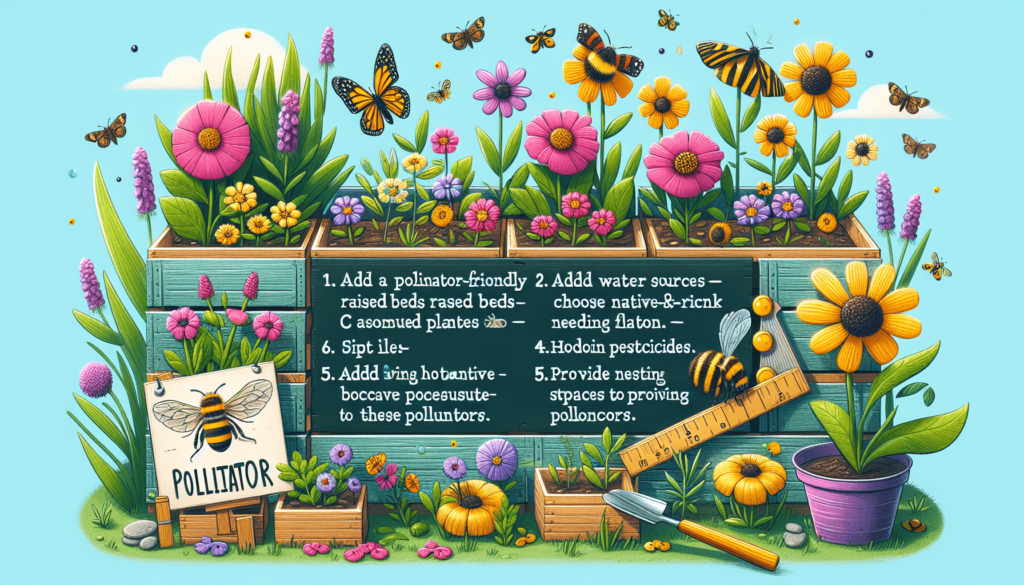
Building Raised Beds with Pollinator-Friendly Materials
Choosing untreated wood
When constructing raised beds for pollinator-friendly gardening, it’s important to choose materials that are safe for both plants and pollinators. Opt for untreated wood, such as cedar or redwood, which doesn’t contain harmful chemicals that can leach into the soil and affect plants and insects. Treated wood, like those preserved with creosote or pressure-treated with chemicals, can be toxic to plants and pollinators. Untreated wood is a durable and eco-friendly option that provides a natural and safe environment for your plants and the pollinators that visit them.
Avoiding chemically treated materials
In addition to avoiding treated wood, it’s essential to avoid using chemically treated materials in the construction of your raised beds. This includes using untreated wood screws or nails instead of galvanized or coated fasteners, as the chemicals in these products can leach into the soil over time. Similarly, avoid using synthetic or plastic liners, as they may release harmful chemicals as they degrade. By using only natural and untreated materials in the construction of your raised beds, you’ll create a healthier and safer environment for both plants and pollinators.
Using organic or compost-enriched soil
The soil in your raised beds plays a critical role in the health and vitality of your plants and the pollinators they attract. To create a pollinator-friendly environment, use organic or compost-enriched soil in your raised beds. Organic soil is free from synthetic fertilizers and pesticides, reducing the risk of harmful chemical exposure to pollinators. Compost-enriched soil improves the fertility and structure of the soil, providing essential nutrients for plant growth and supporting a diverse soil microbiome. By using organic or compost-enriched soil, you’ll create a nutrient-rich and healthy growing medium that benefits both your plants and the pollinators that rely on them.
Mulching with organic materials
Mulching your raised beds with organic materials offers multiple benefits to your plants and pollinators. Organic mulch helps conserve soil moisture, suppresses weed growth, and regulates soil temperature. It also improves soil structure and provides organic matter as it decomposes, further enhancing soil fertility. When choosing mulch, opt for organic materials like straw, wood chips, or compost. Avoid synthetic mulches, such as plastic or rubber, as they don’t break down naturally and can release harmful substances into the environment. By mulching with organic materials, you’ll create a favorable environment for your plants and provide additional habitat for soil-dwelling pollinators and beneficial organisms.
Proper Bed Design to Attract Pollinators
Optimizing bed size and shape
The size and shape of your raised beds can impact their attractiveness to pollinators. As a general rule, wider and shallower beds are more appealing to pollinators because they provide a larger area for planting a diverse range of flowers. Additionally, opting for rectangular or square-shaped beds allows for better access and maneuverability for pollinators. Consider the space available in your garden and the needs of different pollinators when designing the size and shape of your raised beds. By optimizing bed size and shape, you’ll create a visually appealing and accessible environment for pollinators to visit and interact with your plants.
Ensuring easy access to flowers
To maximize the attractiveness of your raised beds to pollinators, it’s important to ensure easy access to flowers. Provide enough space between plants to allow pollinators to move freely and reach the nectar and pollen-rich flowers. Avoid overcrowding and regularly thin out dense areas to maintain adequate air circulation and prevent the spread of diseases. Additionally, consider the height of the plants and their position within the bed. Taller plants should be positioned towards the back or center of the beds to prevent shading of smaller flowers. Ensuring easy access to flowers will attract more pollinators and increase the chances of successful pollination.
Creating diverse heights and layers
Creating diverse heights and layers within your raised beds is crucial for attracting a wide range of pollinators. By incorporating plants of varying heights and structures, you’ll provide for the differing preferences of pollinators. Some pollinators, such as hummingbirds, prefer taller flowers, while others, like bees, prefer shorter blooms. Include a mix of tall perennials, medium-sized shrubs, and low-growing ground covers to create a layered effect. This not only adds visual interest but also provides diverse habitats and foraging opportunities for pollinators. By creating diverse heights and layers, you’ll increase the overall attractiveness and functionality of your raised beds for pollinators.
Including windbreaks and barriers
Including windbreaks and barriers in the design of your raised beds can help create a more favorable and sheltered environment for both plants and pollinators. Strong winds can not only damage delicate flowers but also make it difficult for pollinators to navigate and feed. By placing windbreaks, such as trellises, fences, or densely planted shrubs, around your raised beds, you’ll provide protection from strong winds. Similarly, barriers like low walls or solid structures can create microclimates within the beds, providing additional warmth and protection. By including windbreaks and barriers, you’ll ensure the comfort and safety of pollinators while enhancing the overall success of your raised beds.
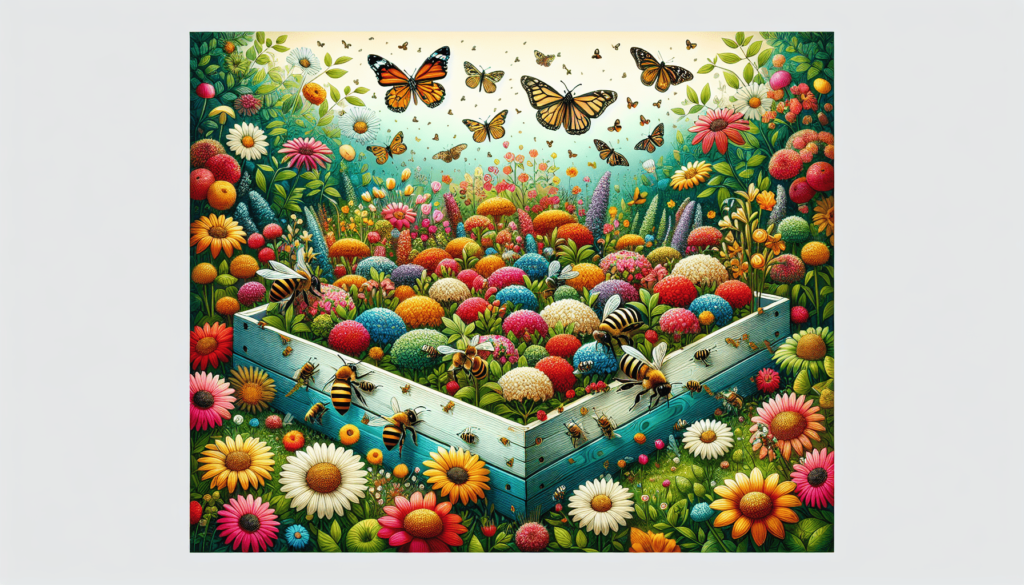
Maintaining Pollinator-Friendly Raised Beds
Regular watering and soil moisture
Maintaining proper soil moisture is essential for the health and vitality of your plants and the pollinators they attract. Regularly watering your raised beds helps ensure that plants have an adequate supply of water for growth and flower production. The frequency and amount of watering will depend on the specific needs of the plants in your raised beds. Monitor soil moisture levels by checking the top few inches of soil with your finger. If it feels dry, water the beds thoroughly. Avoid overwatering, as this can lead to root rot and other issues. Consistent watering practices will keep your raised beds thriving and attractive to pollinators.
Mulching to retain moisture
Applying mulch to your raised beds is an effective way to retain soil moisture and reduce the need for frequent watering. Organic mulch acts as a protective layer, preventing moisture loss through evaporation and regulating soil temperature. Spread a layer of mulch around your plants, taking care not to cover the stems or crowns. The mulch will help keep the soil moist and cool, promoting healthy plant growth and attracting more pollinators. Regularly replenish the mulch layer as it decomposes over time. By mulching your raised beds, you’ll conserve moisture, suppress weed growth, and create an optimal environment for both plants and pollinators.
Pruning and deadheading flowers
Regular pruning and deadheading of flowers in your raised beds not only keeps them tidy and visually appealing but also benefits pollinators. Pruning involves removing dead or damaged plant material, while deadheading refers to removing spent flowers. Both practices redirect the plant’s energy towards new growth and flower production, ensuring a continuous supply of fresh blooms for pollinators. Additionally, pruning can help maintain the desired shape and size of the plants, preventing overcrowding and providing better access to flowers for pollinators. As you prune and deadhead, keep an eye out for signs of pest damage or disease and take appropriate measures to address them.
Removing invasive plants
Invasive plants can quickly take over raised beds and crowd out native or beneficial plant species. These plants can outcompete native plants for resources and disrupt the natural balance of the ecosystem. Regularly inspect your raised beds for any invasive plants and remove them promptly. Invasive species, such as Japanese knotweed or purple loosestrife, can spread rapidly and pose serious threats to the health of your plants and the pollinators that rely on them. By proactively removing invasive plants, you’ll maintain the integrity and functionality of your raised beds as a pollinator-friendly habitat.
Avoiding Pesticides and Harmful Chemicals
Using organic pest control methods
To maintain a pollinator-friendly environment in your raised beds, it’s important to avoid the use of synthetic pesticides. These chemicals are toxic to both pests and beneficial insects, including pollinators. Instead, opt for organic pest control methods to manage pest populations in an environmentally friendly way. Organic pest control methods include handpicking pests, using insecticidal soaps or oils, and employing physical barriers like netting or row covers. These methods target specific pests while minimizing harm to beneficial insects. By using organic pest control methods, you’ll protect pollinators while maintaining a healthy and thriving ecosystem in your raised beds.
Avoiding synthetic pesticides
Synthetic pesticides, commonly found in conventional gardening products, can have detrimental effects on pollinators and the overall ecosystem. These chemicals not only kill pests but also harm beneficial insects, contaminate soil and water, and accumulate in the food chain. Avoid the use of synthetic pesticides in and around your raised beds to create a safe and pollinator-friendly environment. Instead, focus on preventive measures, like maintaining healthy soil, using beneficial insects, and practicing proper plant spacing and hygiene. By avoiding synthetic pesticides, you’ll protect pollinators and promote a more sustainable and chemical-free approach to gardening.
Minimizing chemical fertilizers
While plants need nutrients for growth and flowering, excessive use of chemical fertilizers can have negative impacts on pollinators and the environment. Chemical fertilizers typically contain high levels of nitrogen, phosphorus, and potassium, which can leach into the soil and water, leading to nutrient imbalances and pollution. To minimize the reliance on chemical fertilizers, focus on building healthy soil through the addition of compost, organic matter, and natural amendments. These materials provide a diverse range of nutrients and microbial activity, fostering a balanced soil ecosystem that supports plant growth and attracts pollinators. By minimizing the use of chemical fertilizers, you’ll create a more ecologically sound and pollinator-friendly environment.
Encouraging natural predator-prey balance
Maintaining a natural predator-prey balance is crucial for long-term pest control in your raised beds. By encouraging the presence of beneficial insects and predators, you’ll naturally reduce pest populations and minimize the need for chemical interventions. Avoid using broad-spectrum pesticides that kill indiscriminately and harm beneficial insects. Instead, focus on creating a diverse and inviting environment for natural predators, such as ladybugs, lacewings, and predatory wasps. Incorporate flowering plants that provide nectar and pollen sources for these beneficial insects. By supporting the natural predator-prey balance, you’ll promote a healthier and more resilient ecosystem that benefits both plants and pollinators.
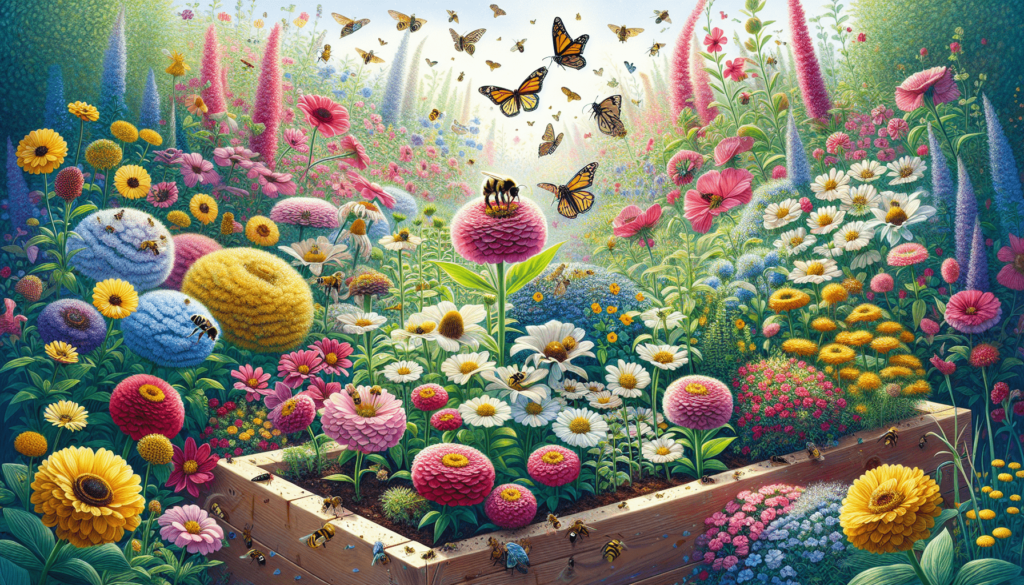
Promoting Native Pollinator Species
Understanding local pollinator populations
To effectively promote native pollinator species in your raised beds, it’s important to understand the local pollinator populations in your area. Research and identify the native bees, butterflies, and other pollinators that inhabit your region. Learn about their behaviors, life cycles, and habitat requirements. This will help you make informed choices when selecting plant species and designing your raised beds. Understanding local pollinator populations allows you to create a tailored and attractive environment that meets their specific needs, ultimately supporting their health and survival.
Planting host plants for specific native species
Many native pollinator species have specific host plant requirements for their larvae and caterpillars. These plants provide essential food and shelter during the early stages of the insects’ life cycles. Research and identify the host plants for specific native species in your area. Incorporate these plants into your raised beds to provide breeding and nesting sites for these pollinators. For example, milkweed is the host plant for monarch butterflies, while violets serve as host plants for fritillary butterflies. By planting host plants, you’ll support the complete life cycles of native pollinators and contribute to their conservation.
Supporting local conservation efforts
Supporting local conservation efforts is a proactive way to promote native pollinator species in your raised beds and beyond. Get involved with local conservation organizations or community groups that focus on pollinator conservation. Attend workshops or seminars to learn more about native pollinators and their habitat needs. Participate in citizen science initiatives and share your observations and data with researchers and conservationists. By actively engaging in conservation efforts, you’ll contribute to the protection and restoration of native pollinator populations, creating a more sustainable and pollinator-friendly environment for future generations.
Educating others about native pollinators
Raising awareness and educating others about native pollinators is crucial for their long-term conservation and the creation of pollinator-friendly habitats. Share your knowledge and passion for native pollinators with friends, family, and your local community. Discuss the importance of native plant species, pollinator-friendly gardening practices, and the role of pollinators in our food system. Encourage others to create their own pollinator-friendly raised beds and provide resources and information to help them get started. By educating others about native pollinators, you’ll inspire action and create a network of individuals committed to supporting these vital creatures.
Monitoring and Assessing Pollinator Success
Recording pollinator visits and activity
Monitoring and recording pollinator visits and activity in your raised beds can provide valuable insights into the effectiveness of your efforts. Take note of the type and number of pollinators visiting your garden, the plants they prefer, and the times of day they are most active. Keep a log or a journal to record your observations and document any changes or patterns you notice. This data can help you evaluate the success of your pollinator-friendly practices and make informed decisions about plant selection and garden maintenance in the future.
Documenting plant growth and reproduction
Alongside monitoring pollinator activity, it’s important to document the growth and reproduction of your plants in your raised beds. Record the growth rates, bloom times, and overall health of your plants. Note which plants are thriving and attracting the most pollinators. Document any signs of disease or nutrient deficiencies and make adjustments as necessary. By documenting plant growth and reproduction, you’ll be able to assess the overall health and success of your raised beds and make informed decisions to improve the attractiveness and functionality of your pollinator-friendly garden.
Noting changes in pollinator diversity
As you monitor and assess your pollinator-friendly raised beds, be aware of any changes in pollinator diversity over time. Pay attention to the variety and abundance of different pollinator species visiting your garden. Notice whether certain pollinators are more or less prevalent compared to previous seasons. Changes in pollinator diversity could indicate shifts in local populations or the impact of external factors like climate change or habitat loss. By noting changes in pollinator diversity, you can adapt your gardening practices to better support the pollinators that need it most.
Making adjustments based on observations
Based on your observations and assessments, make adjustments to your raised beds to further enhance their pollinator-friendly qualities. Consider adding more native plant species, altering the placement or size of plants, or providing additional nesting sites or resources. Take into account the preferences and needs of the pollinators that visit your garden and ensure that their requirements are being met. By making adjustments based on your observations, you’ll continue to improve the attractiveness and success of your pollinator-friendly raised beds and create an environment that supports a diverse range of pollinators.
Creating Pollinator-Friendly Raised Beds requires careful planning and consideration. By choosing the right location, selecting suitable plants, providing nesting and resting sites, using natural pest control methods, building with pollinator-friendly materials, designing beds properly, maintaining the beds, avoiding harmful chemicals, promoting native pollinator species, and monitoring their success, you can create a thriving and enticing habitat for pollinators in your garden. Your efforts to create pollinator-friendly raised beds will not only benefit the plants and pollinators in your immediate surroundings but also contribute to the conservation of these vital creatures on a larger scale. Start building your own pollinator-friendly raised beds and enjoy the beauty and benefits they bring to your garden!

